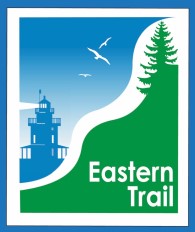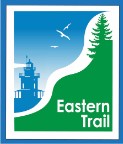By Sally McMurdo | The Conway Daily Sun | June 2, 2017
This spring, Peter and I explored the southern Maine coast from Cape Elizabeth to Cape Neddick. After our daily weekday trips from Conway to Scarborough for medical treatments, we picked places to go afterwards, depending on the weather and our energy. Sometimes, we chose a beach day at Higgins, Ferry, Wells, Crescent Beach or Kettle Cove, where we’d bird watch, sea glass hunt or just walk.
On foul weather days, we might head inland to explore. But the one place we visited the most was the Eastern Trail in Southern Maine. We especially liked the section from Black Point Road in Scarborough to Pine Point Road. There was something about walking out this rail trail across the marsh that called to us. Maybe it was the ease of the walk and later the ride, maybe it was the abundant bird life we saw or maybe it was just the constant flowing and ebbing of the tide that calmed and renewed our spirits.
The Eastern Trail is a “transportation-recreation greenway connecting Kittery in southern most Maine to Casco Bay in South Portland.” Currently, it travels 65 miles from Kennebunk to Bug Light Park in South Portland. It is part of the East Coast Greenway, a 300 mile pedestrian/bike route connecting Calais, Maine and Key West, Florida. The Eastern Trail section has 22 miles of “off-road” riding on an abandoned rail corridor that is hard-packed enough to be stroller and wheelchair friendly. Other sections of the trail are “on-road” connectors to the main rail trail and wind through neighborhoods and small communities. For maps and information, go to: http://www.easterntrail.org/
Currently, the Eastern Trail Alliance is working on a $3.8 million project to “Close the Gap” between Scarborough and South Portland. There is a 1.6 mile key piece missing to connect South Portland’s 5+mile Greenway and the 10+ off-road miles through Scarborough, Old Orchard Beach and Saco. This interruption sends trail users onto heavily trafficked local roads — not a safe or enjoyable experience for anyone. With the support of Maine DOT, PACTS (Portland Area Comprehensive Transportation System), and other generous donors, this project is aiming for completion by 2018. Look for news of its completion.
But, I diverge. Let’s go back to that special section over the Scarborough Marsh from Black Point Road to Pine Point Road. The marsh itself is remarkable. Scarborough Marsh is a 3,200-acre saltwater marsh owned by the state of Maine and managed by the state’s Department of Inland Fisheries and Wildlife as a wildlife management area. It is Maine’s largest saltwater marsh complex. As such, it supports a varied aquatic life population as well as many types of waterfowl, and even occasional seals and porpoises. It supports two oyster farms and clamming operations. As a stopover on the Atlantic Flyway, it is a great area for bird watching. The marsh is also a place frequented by kayakers, paddle boarders, and, of course, fishermen. We have seen them all in our visits to the marsh along the Eastern Trail.
Until recently, all our visits to the marsh have been on foot. We either started at the northern end, off Black Point Road, or at the southern end, off Pine Point Road. Look for green “ET” road signs to direct you to the trail heads. Both ends have adequate parking and kiosks with information and maps. From one end to the other is about 2 miles one way. If we’re eager to see the marsh activity, we start at Pine Point and go about a mile. Along the way, there are benches for marsh watching and interpretative signs to give information about marsh birds and animals. If we’re looking for a more protected, shady walk, we start at Black Point.
Last Wednesday, we decided to bring our bikes instead of sneakers. The weather looked promising — not too hot, rainy or cold. We started from the larger Black Point parking lot with the goal of riding at least 10 miles round trip. That doesn’t sound like much, but for people who hadn’t been out on their bikes this season, it was a good start. We wanted to see what lay beyond the section we knew, so we rode out with Saco as our objective.
That day, we saw more cyclists on the trail than we had seen all spring. Peter remarked that when it gets warm, bugs and bicyclists come out in droves. When it’s cool, the walkers, runners and baby joggers hit the trail. Wednesday, with striped bass (stripers) coming up the coast, there were some fishermen, too, casting their lines into the marsh from the easy access of the trail and its bridges. Birdwatchers are there no matter what the weather.
Read the entire article online here.
<!– the rest of the article in case the online version goes awau
The ride to the marsh section passes a golf course, pond and shady woods before breaking out in the open in about a mile. A bench, strategically placed, gives a panoramic view of the marsh. A quick rest there with a pair of binoculars lets trail travelers spy on all the varied birdlife — Canada geese, egrets, ospreys, cormorants, glossy ibis and more. It’s a good people watching spot, too, where you can see people of all ages enjoying the path by foot or wheel.
A mile across the marsh on this elevated railway corridor brought us to the Pine Point parking lot and kiosk. There, we crossed Pine Point Road, and began the trail section from Scarborough to the towns of Old Orchard Beach and Saco. We rode slightly uphill for 3 miles on a wide, forested trail. Trail users were fewer here, though we did see several bicyclists coming and going. Along the way, spur trails went to ball parks, neighborhoods, and places unknown, connecting them to the Eastern Trail. At road crossings, not only was there a highly visible cross walk, but there was also a signal light that trail users could activate to stop traffic. We found we didn’t need to use the signal because courteous and attentive drivers always stopped for us.
In our haste to get out on our bikes that morning, we forgot several important items — a pump, pack, and water bottle cage for Peter’s bike. I transferred a pack to my bike, took the largest water bottle in my cage, and hoped we wouldn’t flat along the way. By the time we had ridden 5 miles out, we were getting thirsty and our lone bottle warm. Imagine our surprise to find a water station right where we needed it! Paid for and maintained by Maine Water Company and others, this station has a spigot for filling water bottles, a drinking fountain, and even a stainless bowl for Fido’s water nearby. What a great idea for a multi-use recreation path!
Refreshed from that cool water and snacks in the pack, we turned around and cruised downhill to Pine Point Road. Crossing over, we pedaled to the bridge over the marsh, stopping there to talk to a striper fisherman and watch the tide coming in. We finished the last section to the car with 10 miles under our wheels and smiles on our faces. It wasn’t a fast or far ride, but it was surely a pleasurable one suitable for families, old folks like us, and anyone who wants to get out for exercise and fresh air in a beautiful setting!
The Eastern Trail met and exceeded my criteria for a quality rail trail. It was away from traffic, had gentle inclines/ declines, afforded scenic views of countryside and wildlife, and connected communities and interest points. Any number of side trips to the beaches, campgrounds, or Route 1 amenities could be accomplished by riding bike lanes along Black Point, Pine Point or other connector roads in either direction east or west. In the numerous times we visited there, I never was bored. Riding or walking across the marsh, I always saw or felt something interesting and energizing about the place.
The next time you travel towards Portland, turn south on Route 1 to Scarborough, turn on Black Point Road or Pine Point Road. Follow the green ET signs to find the trailheads. Grab your bikes or sneakers and discover the Eastern Trail and Scarborough Marsh.
–!>












0 comments
Write a comment